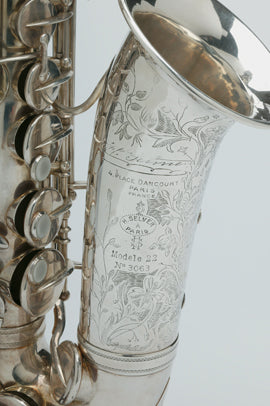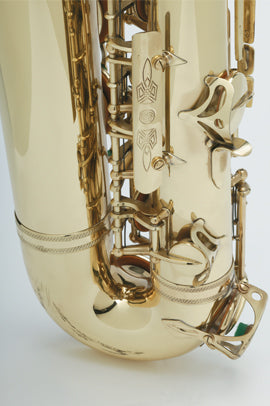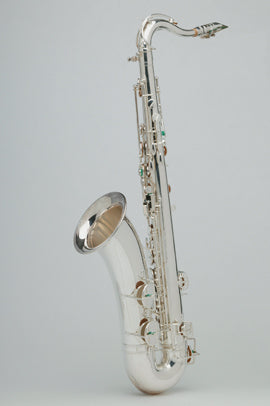The history of legendary Selmer saxophones

Série 1922 and Modèle 22 (1922-1926)

Paul, Henri (1905) and Maurice Lefèvre (at the end of 1907), were hired by Selmer and placed in charge of instrument production.
After the war, Henri Lefèvre adapted new manufacturing techniques for the saxophone. He systematized the drawing of tone holes which were previously welded into the body of the instrument. This new technique simplified manufacture, eliminated the leakage problems and introduced an improved standardization of manufacture.
“Série 1922” –an alto and the first great saxophone series manufactured by Selmer– was launched officially on December 31, 1921 at a time when the saxophone was very much in vogue in the United States. Replacing the “Série 1922”, the “Modèle 22” was a technically innovative, more streamlined and stronger construction compared to traditional workmanship. The automatic octave key was already offered on this model.

Encouraged by the warm reception which greeted the arrival of this saxophone, the Selmer company decided to go ahead with the production of the straight Bb soprano, the curved soprano, the soprano in C and the tenor saxophones in Bb and C, the latter being better known under the name “C Melody”. Shortly afterwards the rest of the family was made available. The “C Melody” was particularly popular amongst jazz musicians during the twenties. The key of C eliminated the need for transposition making it a perfect partner to play with the piano. But even though it was easy to play and pleasant to listen to, it struggled to find its place. Coleman Hawkins began his career with the “C Melody”, but without question the greatest virtuoso on this saxophone remains Frankie Trumbauer (1901-1956), whose facility and skill even Benny Carter himself once admitted to never having had. Even today, his solo on Singing The Blues with Bix Beiderbecke is still often covered note for note in its entirety.
► More information about Model 22
Modèle 26 and Selmer Super Sax (1926-1935)
The decade 1926-1936 proved decisive in the development of the Selmer saxophones. Indeed, their fame had spread internationally, while at the same time the instruments continued to benefit from constant improvements. In 1929, Selmer acquired the company Adolphe Sax & Co whose workshops were located on 84 rue Myrha, in the eighteenth arrondissement of Paris. Paradoxically, this acquisition (which made Selmer the sole legatee to the brilliant inventor) enabled Selmer to start producing a brass range, one of the great specialities of Sax at the time.

Between 1926 and 1928, “Modèle 26” was embossed with the new Selmer logo (trademark). On this model appeared a new neck escutcheon and a new neck key, designed in the form of a “wishbone”. Some of the “Modèle 28’s” were produced side by side with unnamed prototypes that came out the same year, as was the case until 1931. In 1929, an alto was made with a larger bore, and which the Americans called New large bore.
For this period, it is difficult to precisely date the models because of the variety of bodies and bells used. Even two instruments of the same model might comprise appreciably different keys and even mechanisms, depending upon the requests of the musicians.
From 1931, certain saxophones were marked with a triple “S” : Super Sax Selmer. They were not limited to just one series but were distributed over several models:
-
The Cigar Cutter model (1931 to 1934), so-called by the Americans because of its octave key design, was also characterized by its V-shaped guard and a narrow but thicker neck slide that was machined from massive nickel silver.
-
The Radio Improved model (1934-35) was created for radio sound-takes and studio recordings; there are, however, very few existing units.
The ergonomic refinement and greater instrumental accuracy generated by successive developments in the model range, enabled Selmer to delineate itself from its competitors. This process of differentiation led to a revolutionary model: the “Balanced Action”.
► More information about Model 26, Large Bore, Cigar Cutter and Radio Improved
Balanced Action, the revolution (1936-1947)

The “Balanced Action” is the basic prototype of the modern saxophone and the majority of the changes built into it have been kept to this day. The keywork was entirely redesigned. The low B and Bb keys were moved to the right side of the bell, allowing for easier operation of the keywork. The origin of the name “Balanced Action” lies in its balanced keywork and distribution of weight. Coleman Hawkins chose to play on this model at the end of the Thirties.
In fact, with this saxophone, there is a return to the initial spirit of the esthetics of the Selmer sound : the bore is bigger and the bell is a larger diameter. This improvement thus made it possible for Selmer to become a real challenger next to the American saxophones of the time.

In its design, the “Balanced Action” Tenor was characterized by distinct low B and Bb guards, and spatula groups with a newer, more ergonomic form (the left-hand little finger and right-hand little finger). The “Balanced Action” came in two versions, either with a long or short bell. The long bell was more accurate, but more demanding in terms of blowing. The short bell was preferred for its greater blowing ease, but on the other hand, played the low registers slightly too high. An important development in extending the range of the instrument was the addition of a high F# option, offered here for the first time. Also of note was the asymmetry of the register key support which was fitted for side-on play, the preferred position at the time.

During the Second World War, the company ran into problems due to a lack of raw materials, particularly in brass and mother-of-pearl. This shortage explains why many “Balanced Action” saxophones were equipped with black bakelite instead of traditional mother-ofpearl buttons. In the same way, during the period from 1942 to 1945, some “Balanced Action” models appeared with differing classification numbers on their body and bell as a result of discrepancies within the inventory during the war (in this case, the real number is that of the bell).
► More information about the Balanced Action
Super Action, transition to Mark VI (1948-1953)
This saxophone, also known by the name “Super Balanced”, is to some extent a transitional instrument falling between the “Balanced Action” and “Mark VI”.

In contrast to “Balanced Action”, it featured a removable bow, which allowed for much easier maintenance. The body and bow were fitted together with the help of a collar maintained by two screws, while the bell remained welded on the bow.
The principal development related to the ergonomics of the keywork, which was rearranged to enhance playing comfort.
► More informartion about the Super Action
Mark VI, the legend (1954-1973)

“Mark VI” drew its name from its position as sixth model since the production of the first saxophone in 1922. The inscription “Mark VI” can be found in several places on the saxophone; usually on the ring, sometimes on the bell and even on the body of the instrument. “Mark VI” celebrated the 50th anniversary of the Gold Medal won in 1904 at the Saint-Louis Exhibition in Missouri. From 1951, Marcel Mule himself became passionately involved in the creation and development of the new Selmer saxophone.
The production of “Mark VI”, a truly legendary instrument, continued for more than twenty years. It was distinguished notably by a new design of the octave key spatula and the left- and right-hand plastic thumb rests. Compared to the “Balanced Action”, the return to a smaller bore meant an improvement in the flexibility of playing while still preserving good projection.

The flexibility of this instrument rapidly increased its popularity amongst all saxophonists whatever their style. The keywork delivered an exceptional comfort by removing many playing constraints. On the new neck key, the “S” of Selmer could be found engraved on a blue background. For the first time, “Mark VI” was equipped with the option of the extra octave vent key, known as the harmonic key, used to facilitate the blowing of overtones. A limited production alto featuring a low A also appeared under the label “Mark VI”, which had fans such as Ornette Coleman.
► More information about the Mark VI
Mark VII, a step towards modernity (1974-1980)

It would take three years of development to turn the page after twenty years of the “Mark VI”. Michel Nouaux, a soloist with the Republican Guard, took part in this challenge. The “Mark VII’s” improvements included a new octave key mechanism and a functional placement of the spatula group for the left-hand little finger, allowing for more flexible passage over the whole of the plate. The keywork was broadened to improve the handling of the instrument. The body to bell ring changed to a ring anchored at three points. And there was the return to the use of a plastic booster on the pads.
It was an instrument completely in step with its time. With the advent of Rock’n’Roll and pop music, the arrival of the “Mark VII” was a natural response, reflecting Selmer’s commitment to the search for a powerful sound, particularly rich in high harmonics.
However, only the alto and tenor saxophones saw the light of day; the soprano and baritone “Mark VII” prototypes started during this period were used instead as a basis for the “Super Action 80” versions.
► More information about the Mark VII
Super Action 80, the second breath (1981-1985)

A change of direction lay in store for the “Super Action 80”. At the request of musicians, its keywork was reduced and made more compact than on the “Mark VII”. In fact, with the “Super Action 80”, Selmer revisited the ergonomics of the “Mark VI” while at the same time preserving the acoustical progress made by the “Mark VII”. Modifications to the dimensions of the neck and bow, combined with a return to metal boosters led to a further enrichment of the sound.
► More information about the Super Action 80
 Want to buy one of these vintage saxophones? Take a look at our ReWIND service, offering second-hand saxophones and former exhibition models for sale. Want to buy one of these vintage saxophones? Take a look at our ReWIND service, offering second-hand saxophones and former exhibition models for sale. |
► Go the the serial number chart
► Discover the History Notes series